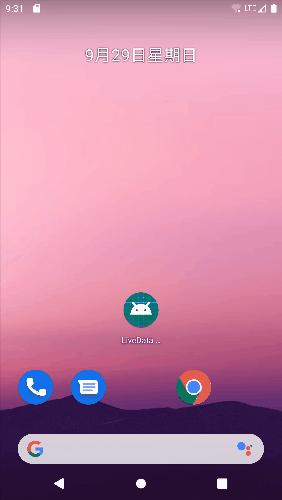Android APP开发中,开发者们都想有一个公共的组件,可以实现后台数据的监听,同时实时更新到UI进行显示,从而大大简化开发过程。Google针对这一开发需求,提供了Jetpack LiveData组件。下面我们来一起看下LiveData的基本使用方法吧!
首先,先了解下使用LiveData的优点。
-
确保UI与数据状态匹配
-
不需要担心内存泄漏问题
-
Activity停止后数据变化不会导致Crash
-
不再需要人工生命周期的处理
-
始终使用最新的数据
-
正确应用配置更改
-
共享资源
LiveData遵循观察者模式,实现LifeCycle接口,因此可以监听数据的实时更新,感知应用的生命周期,让开发者能够更多的关注业务具体实现。
下面我们来通过一个小Demo来简单介绍下LiveData的基本使用方法。

本例中,数据变化通知UI的显示由四个控件体现,分别为:系统时间(Long型)、系统时间、天气、远端数据。针对这四个控件的动态显示,我们分别来看下其是如何实现的。
框架搭建
APP首先需要搭建使用LiveData的环境:
1. 导入依赖包
//app build.gradle
dependencies {
...
implementation deps.lifecycle.viewmodel_ktx
implementation deps.lifecycle.livedata_ktx
...
}
## 2. 创建ViewModel类(用于LiveData数据的封装,和UI交互)
``` class LiveDataViewModel( private val dataSource: DataSource ) : ViewModel() {...} ```
## 3. 布局文件中引用ViewModel对象
<layout>
<data>
<variable
name="viewmodel"
type="com.android.example.livedatabuilder.LiveDataViewModel" />
</data>
...
</layout>
## 4. Activity绑定ViewModel
``` //MainActivity //成员变量 private val viewmodel: LiveDataViewModel by viewModels { LiveDataVMFactory } //onCreate val binding = DataBindingUtil.setContentView
// Bind ViewModel
binding.viewmodel = viewmodel
//LifeDataVMFactory
object LiveDataVMFactory : ViewModelProvider.Factory {
private val dataSource = DefaultDataSource(Dispatchers.IO)
override fun <T : ViewModel?> create(modelClass: Class
@Suppress("UNCHECKED_CAST")
return LiveDataViewModel(dataSource) as T
}
}
<br/>
### 注意:此处构造ViewModel采用的dataSource为DefaultDataSource,后续数据是根据此数据源来进行获取的。
<br/>
# 系统时间(Long型)显示
<br/>
系统时间的显示,通过在UI上绑定ViewModel,通过getCurrentTime方法后台更新、提交数据,来通知UI进行显示的更新。
<br/>
//xml
<TextView
android:id="@+id/time"
android:text="@{Long.toString(viewmodel.currentTime)}"
.../>
//LiveDataViewModel
val currentTime = dataSource.getCurrentTime()
//DefaultDataSource
override fun getCurrentTime(): LiveData
liveData {
while (true) {
emit(System.currentTimeMillis())//通知当前系统时间
delay(1000)//延时1秒
}
}
<br/>
# 系统时间显示
<br/>
系统时间的显示是根据系统获取的Long型变量变化映射得到的,Long值发生变化时,实时更新系统时间显示。
<br/>
//xml
<TextView
android:id="@+id/time_transformed"
android:text="@{viewmodel.currentTimeTransformed}"
.../>
//LiveDataViewModel 此处有两种方式实现
//1. currentTime变更后实时通知UI更新
val currentTimeTransformed : LiveData
Date(it).toString()
}
//2. 延时500ms后通知
val currentTimeTransformed = currentTime.switchMap {
// timeStampToTime is a suspend function so we need to call it from a coroutine.
liveData { emit(timeStampToTime(it)) }
}
private suspend fun timeStampToTime(timestamp: Long): String {
delay(500) // Simulate long operation
val date = Date(timestamp)
return date.toString()
}
<br/>
# 天气显示
<br/>
天气的显示通过动态改变数据源提供的数据,从而通知UI显示(DataSource数据的更新实时通过LiveData传递到UI)。
<br/>
//xml
<TextView
android:id="@+id/current_weather"
android:text="@{viewmodel.currentWeather}"
.../>
//LiveDataViewModel
val currentWeather: LiveData
emit(LOADING_STRING)
emitSource(dataSource.fetchWeather())
}
//DefaultDataSource
private val weatherConditions = listOf("Sunny", "Cloudy", "Rainy", "Stormy", "Snowy")
override fun fetchWeather(): LiveData
var counter = 0
while (true) {
counter++
delay(2000)//延时两秒
//按顺序循环显示weatherConditions中的天气数据信息
emit(weatherConditions[counter % weatherConditions.size])
}
}
<br/>
# 远端数据显示
<br/>
远端数据的请求通过Button的点击事件触发,数据获取成功后,通知TextView进行数据显示。
<br/>
//xml
<TextView
android:id="@+id/cached_value"
android:text="@{viewmodel.cachedValue}"
.../>
<Button
android:id="@+id/refresh_button"
android:onClick="@{() -> viewmodel.onRefresh()}"
.../>
//LiveDataViewModel
val cachedValue = dataSource.cachedData
fun onRefresh() {
// Launch a coroutine that reads from a remote data source and updates cache
viewModelScope.launch {
dataSource.fetchNewData()
}
}
//DefaultDataSource
private val _cachedData = MutableLiveData("This is old data")
override val cachedData: LiveData
override suspend fun fetchNewData() {
// Force Main thread
withContext(Dispatchers.Main) {
_cachedData.value = "Fetching new data..."
_cachedData.value = simulateNetworkDataFetch()
}
}
private var counter = 0
// Using ioDispatcher because the function simulates a long and expensive operation.
private suspend fun simulateNetworkDataFetch(): String = withContext(ioDispatcher) {
delay(3000)//延时3秒
counter++
"New data from request #$counter"//返回此字符串
}
<br/>
##### 小提示:本例中的viewModelScope使用的是Kotlin Coroutines(协程)功能,更多协程使用方法,请查看Coroutines在架构组件中的应用:[官方文档链接](https://developer.android.google.cn/topic/libraries/architecture/coroutines)[]()
<br/>
远端数据的更新流程为:<br/><br/>
<center>

</center>
<br/>
将上述四个控件分别绑定对应的LiveData对象,增加其数据变化,就能够实现前文描述的APP动态变化效果了。
<br/>
[帮助文档](https://developer.android.google.cn/topic/libraries/architecture/livedata)
 
[源码路径](https://github.com/android/architecture-components-samples)<br/><br/>
小技巧: github 代码下载速度慢,可以克隆到码云上(gitee.com)再下载。
<br/><br/>
通过这四个控件的LiveData与UI的交互使用,你学会如何使用LiveData了吗?
<br/><br/>
<center><font color='green'>欢迎关注公众号,留言讨论更多技术问题。</center>
<center>

</center>